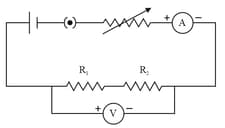You are given four ammeters A, B, C and D having the least counts mentioned below:
(a) Ammeter A with least count
(b) Ammeter B with least count
(c) Ammeter C with least count
(d) Ammeter D with least count
Which of the ammeters would you prefer for doing an experiment to determine the equivalent resistance of two resistances most accurately, when connected in parallel?
(a) Ammeter A with least count
(b) Ammeter B with least count
(c) Ammeter C with least count
(d) Ammeter D with least count
Which of the ammeters would you prefer for doing an experiment to determine the equivalent resistance of two resistances most accurately, when connected in parallel?
Important Questions on Multiple Choice Questions
Consider the two circuits A and B given alongside:
In the circuits A and B shown here, the voltmeter reading would be:
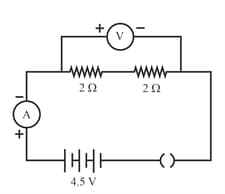

(A) (B)
The values of resistances marked on the coils and are found to be correct. A student connects the given resistors in the following manners (as shown in figure 1).
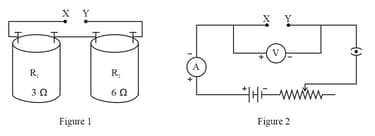
He then connects the terminals marked X and Y of the above combination of resistors R1 and R2 to the terminals marked X and Y in the circuit (shown in figure 2). The average value of the ratio in the observations recorded in the circuit would be:
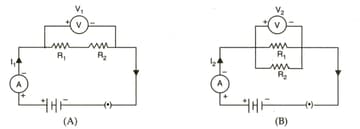
If the ammeter and voltmeter readings in the two cases be , and respectively, he is likely to observe that:
Two students made two circuits A and B to determine the resultant resistance of two resistors and connected in series:
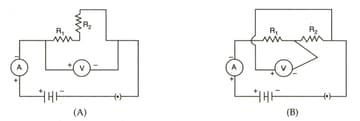
All the components have been connected correctly in:
Four students have made the following circuit diagrams for determining the equivalent resistance of two resistors connected in series:
The correct circuit diagram is:
Consider the following four circuits P, Q, R and S which have been set up to find the resultant resistance of two resistors combined in parallel:
The correct way of connecting the ammeter and voltmeter in the circuit is:
In order to determine the equivalent resistance of two resistors and connected in series, a student made this circuit for his experiment.
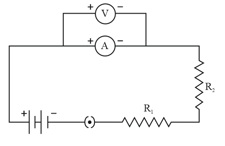
The only statement which is true for this circuit is that it gives:
To find the resultant resistance of two resistors when connected in series, a student arranged the various components according to the circuit shown alongside:
The student, however, did not succeed in his objective. Which of the following mistake has been made by the student in setting up the circuit?
